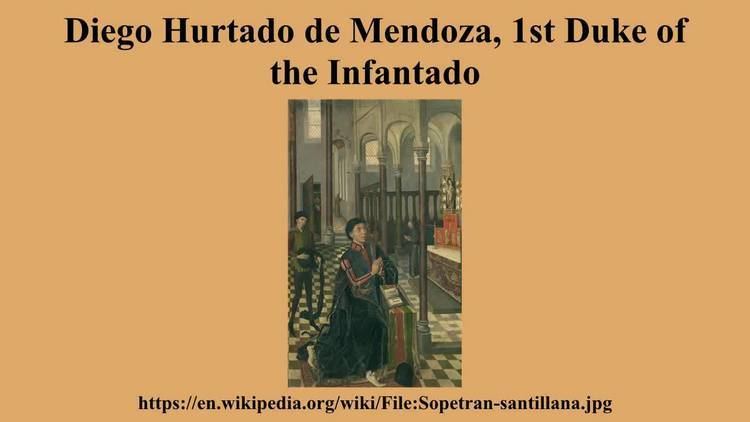Name Diego de | ||
 | ||
Diego Hurtado de Mendoza, 1st Duke of the Infantado
Don Diego Hurtado de Mendoza y Figueroa, 1st Duke of the Infantado, or Diego Hurtado de Mendoza y Suarez de Figueroa (Guadalajara, Castile, 25 September 1417 – Manzanares el Real, Spain, 25 January 1479) was a Spanish noble.
Contents
- Diego Hurtado de Mendoza 1st Duke of the Infantado
- Biography
- Construction of the New Castle of Manzanares el Real
- Marriage and children
- Political background of this Mendozas family branch
- References

Biography

He was the eldest son of the well known literary man of the 15th century, Íñigo López de Mendoza y Lasso de la Vega, (1398–1458), 1st marquis of Santillana since 1447. He became 2nd marquis of Santillana when his father died in 1458.
The title Duke of the Infantado was awarded to him by the Catholic Monarchs, Fernando II de Aragon and Isabel I of Castile, on 22 July 1475.
This was one of the most important duchies in Spain : around 1535, it was associated to the personal lives of some 90,000 vassal families, perhaps about 3-4% of the people from the whole Peninsular kingdoms constituting by then the actual country described as Spain. At that time, that was an enormous amount of people. American conquerors, European and American regions Viceroys, on areas adding up to several hundreds of thousands of square kilometers, cities and estensive territorial areas names, bishops and cardinals of the Catholic Church stem out and settled in many places originating for some 300 years, from this powerful family.
Construction of the New Castle of Manzanares el Real
The old castle of Manzanares el Real was the residence of a part of the Mendoza family since the end of the 14th century. The old castle of Manzanares el Real belonged to one the 1st Duke's aunts, a powerful and ruthless (elder) step sister of his father Íñigo, a duchess named Aldonza de Mendoza(circa 1380–1435). Her mother was a member of the troublesome Royal bastards of the middle of the 14th century, the ubiquitous Enriquez family. When Aldonza died in 1435 the nephew, Íñigo, a Lasso de la Vega by his mother, and father of this 1st Duke, insisted over and over again to King Juan II of Castile, on becoming a count of what is now Manzanares el Real.
In the last third of the 15th century, the House of Mendoza decided to build a new palatial castle, larger and more luxurious, more fitting for the economic and political influence achieved by this family. Diego started the works on the New Castle of Manzanares el Real in 1475, but it was his elder son who finished the works after his death. The castle is used now as a fancy place near Madrid for glamorous weddings, social events, banquets and so on.
Marriage and children
Diego Hurtado married firstly Brianda de Luna y Mendoza. They had:
He remarried with Isabel de Noronha, and had:
Political background of this Mendoza's family branch
This Diego Hurtado de Mendoza got several cadet brothers and sisters, another 9 or so, using different names without much bother on future genealogists:
The Spanish genealogists can go easily out of trouble by calling the first count as Iñigo Lopez de Mendoza y Suarez de Figueroa, while the 2nd count of Tendilla would be described as Iñigo Lopez de Mendoza y Quiñones as his mother came from the Leon kingdom "Quiñones" family.
In 1969, General Francisco Franco, recognized this title for aristocratic lady Marta Cotoner y Martos, married to motor car manufacturer Valeriano Barreiros, 2nd son of self-made motor industry man Eduardo Barreiros y Nespereira. This self-autarchy Spanish cars factory was bought later by the American Chrysler Corporation, while the Barreiros family, an industrial group from Galicia, NW of Spain, where the General came from, were given the status of a protected multiservices company, dealing mainly on Diesel motors manufacturing, trade, agricultural commodities, export, import, cinema and Television business. These industrial ventures related to Spanish Fascism do not seem to arouse today the morbidity of other political events at the time.
